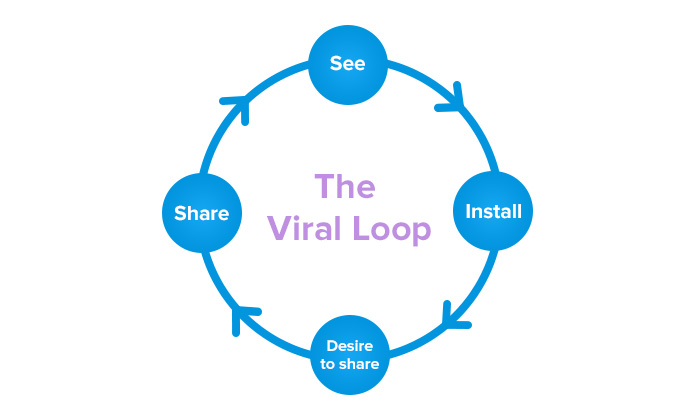All About App Localization and App Downloads Overseas
 Alexandra Lamachenka
Alexandra Lamachenka How do you encourage foreign audiences to download your app?
It’s a real puzzle.
Every day, your app attracts thousands of downloads from the United States. You have a dedicated fan base that gives you rave reviews….
Yet it appears like the rest of the world looks at your app and goes “meh”:
You may think: “That’s because the app is not localized. Translate the listings and your downloads will grow tenfold!” Well, I’ve got bad news for you: this app you see on the graph is localized.
While it does achieve some success overseas, it’s clearly not as popular abroad as it is in the U.S.
Why?
Most of the time, translation doesn’t help you one bit towards overseas growth.
So what do you do when your translation fails to increase app downloads?
Well, hiring a different translator won’t solve the issue. What you should know about app localization is that the translation isn’t the problem – it’s your message that needs fixing. You can’t just change the text; it’s the way your app is perceived overseas that is often drastically different than in your home country.
You have to consider the extra-linguistic factors that are hurting your app’s overseas growth.
Extra-linguistic is just a fancy word . Once you identify and address the problem with your core message, it will be much easier to develop strategies to reach potential foreign users.
In this blog post, I will help you to identify these pain points so that you understand how to fix them.
Let’s get started.
It is a very common strategy for developers to design their apps for virality – to get their users advertising for them.

In the Western world, we like to boast. Feats, achievements, high scores – it is important to us that our friends, relatives, and followers know how successful we are.
Got a promotion? A new job?… update your Facebook profile.
Beat a level in Candy Crush? Share it on Twitter.
Sure, not everyone does this, but I’m sure you’ve already seen friends boast on social media, in one way or another: sharing a picture, tagging themselves at a fancy restaurant, or sharing a selfie in some exotic location.
This applies to apps as well. Timberman is a great example:

This type of app-design encourages users to share their experience with their friends and inspire them to give your app a try.
It can be subtle:
“Want to share this beautiful selfie on social media?”
…or not-so-subtle:
“Share your high score and see if your friends can beat you!”
Asian societies, however, can be quite different.
You will find that your users don’t really like to boast. Body image, achievement motivation and viral loop efficiency are among many things that differ by culture.
If you want your users abroad to write good reviews and share your app, you need to understand what makes your app shareable in the first place.
What drives your users? What influences them?
To answer this question, take a look at the share mechanisms already implemented in your app, then adapt those mechanisms to multiple foreign cultures.
Fortunately, this doesn’t have to be expensive – or difficult – at all.
It can be a matter of a simple change in the wording – as demonstrated in the examples below.
It would be difficult to examine each type of app individually, but here are two very common situations that will help you identify the key factors you need to take into account:
Leaderboards and points are very popular in Western games.
There is a beat-your-friend-and-show-them-you’re-better-than-they-are culture happening with almost every game out there:
Unfortunately, this kind of boasting will not appeal much to some of your foreign users in, say, China.
As collectivistic cultures, they tend to avoid conflict with their social groups. They steer away from direct confrontation and choose not to challenge friends, relatives and peers.
While competition and challenges exist, of course, you’d be better off reassuring those types of potential users that they’re not going to engage in a constant game of one-upmanship with their friends.
Quick example: let’s say your 1v1 quiz game app allows you to invite your friends to test their knowledge against you.
You might have a screen in your app that says, “Sign-up with Facebook to challenge one of your friends in a quick 1v1 battle!” – awesome, those kinds of messages work well and get the competitive juices flowing. Many apps use this kind of incentive to get more users on board.
Want to adapt the message for Chinese users? Easy. Tell your translator that you’d need another kind of phrasing there so that your users do not get the impression that they are in direct competition with their friends.
For example, “help your friends deepen their general knowledge in a quick session with you!” – or something similar.
(Side note: avoid asking your Chinese users to log in with Facebook. QZone is the most popular social network in China.)
North America and Europe are, for the most part, individualistic cultures.
This means that their sense of identity (the idea they have about themselves) and image (how others see and judge them) will be much more important. They want to feel like they are unique and special – so make them feel like they are.
In Asia, however, and some countries in the Middle East and Latin America, your users are more interested in finding harmony with society.
People in those cultures want to be identified as more a part of the collective: instead of empowering themselves or standing out, they want to be seen with others and be a part of the larger group.
Your approach will have to be different here. It has to be more subtle.
Some of your potential users will not want to compete with their friends using the sharing mechanism, but will want to know that they can use your app with their friends.
You want to present it to them as a way to be more social and to work together more as a group (vs. being competitive). It’s an almost unconscious process… but it works.
PicsArt is amazing at doing this. Compare the screenshots they use in the U.S. and in Japan:
You can check the rest of their screenshots here (U.S.) and here (Japan).
No wonder this app is doing great in both countries.
So far, we’ve looked at individualistic and collectivistic cultures.
You now know what to do if you have a photo app and want to attract more users from Japan now, but what about Spain? Or Germany? Are they individualistic (= self-centered, risk-taking, etc.) or collectivistic (= group-centered)?
Fortunately, there’s an easy way to know this as well. Head over to Geert-Hofstede.com and click on Cultural Tools > Country Comparison (or just click on the link above!).
Select the country of your main audience first. (In this example, the United States.)
Then, select the country you would like to target to attract more users.
A chart with the 6 cultural dimensions appears:
The higher the score (U.S.: 91, Japan: 46), the more the society is individualistic. With the U.S., you’re clearly dealing with an individualistic society.
Even though it scores 46 on this chart, Japan is a collectivistic society. That’s because it is still considered quite individualistic when compared to other Asian cultures, such as China (scores 20 in Individualism).
Geert-Hofstede is also an amazing tool to learn more about the culture you want to target.
Simply select your target country as the primary country…
… and scroll down the page to learn more about your future users:
There are plenty of ways to generate more users from overseas if you’re currently stuck at 25-100 downloads a day. Mobile app localization could be a good solution. Adapting your message is just one of the many strategies you can use.
First, ask yourself, what makes your users want to talk to their friends about your app?
Then, implement the strategy described above to better understand your audience abroad and make your app more appealing to them.
Depending on your findings, you might have to change your screenshots or revise a sentence or two to better fit the target audience.
Do you have questions or comments? To make sure everyone profits from the answers, I’ll be responding in the comments section below.
Start studying your target culture today… and let me know how it goes.
